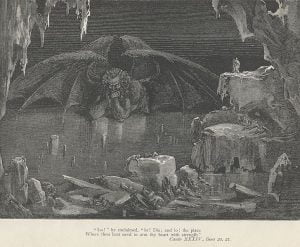The Realm of Hades
Realm of Hades

The underworld Realm of the God Hades is also called Hades, but it also includes the regions of the Elysian Fields, and gateways into Tartarus
The deceased enter the underworld by crossing the river Acheron, ferried across by Charon, who charges, a small coin for passage, placed under the tongue of the deceased by pious relatives. Paupers and the friendless gathered forever on the near shore. The far side of the river was guarded by Cerberus, the three-headed dog defeated by Heracles. Beyond Cerberus, the shades of the departed entered Tartarus, the land of the dead.
The five rivers of Hades are Acheron (the river of sorrow), Cocytus (lamentation), Phlegethon (fire), Lethe (forgetfulness) and Styx (hate). The Styx forms the boundary between upper and lower worlds.
The first region of Hades comprises the Fields of Asphodel, where the shades of heroes wander despondently among lesser spirits, who twitter around them like bats. Only
libations of blood offered to them in the world of the living can reawaken in them for a time the sensations of humanity.
Beyond lies Erebus, whose own name was dread.
There were two pools, that of Lethe, where the common souls flocked to erase all memory, and the pool of Mnemosyne (“memory”), where the acolytes of the Mysteries drank instead. In the forecourt of the baleful palace of Hades and Persephone sit the three judges of the Underworld: Minos, Rhadamanthys and Aeacus. There at the trivium sacred to Hecate, where three roads meet, souls are judged, returned to the Fields of Asphodel if they are neither virtuous nor evil, sent by the road to Tartarus if they are impious or evil, or sent to The Elysian fields if good and virtous.
The Realm of Hades, Acheron
The Realm of Hades, Asphodel Meadows
The Asphodel Meadows is a section of the Ancient Greek underworld where indifferent and ordinary souls were sent to live after death. Hades, the Greek name for the underworld (also the name of the god Pluto) is divided into two main sections: Erebus and Tartarus. Erebus was where the dead first entered the underworld. Charon ferried the dead across the river Styx where they then went into Tartarus.
Tartarus is the section of the underworld where the dead would spend all of eternity in the place where judgment would order them. Tartarus is then divided into three subsections: the Elysian Fields, the Asphodel Meadows, and Tartarus. The Elysian Fields were for the good and heroic souls where they would be forever happy. Tartarus was where the evil and treacherous souls were sent to live out eternity in horrible punishment.
Geography
The Asphodel Fields is where the souls of people who lived lives of near equal good and evil rested. It essentially was a plain of Asphodel flowers, which were the favorite food of the Greek dead. It is described as a ghostly place that is an even less perfect version of life on earth. Some depictions describe it as a land of utter neutrality. That is, while the people are neither good nor evil, so are their lives treated, as they mechanically perform their daily tasks. Other depictions have also stated that all residents drink from the river Lethe before entering the fields, thus losing their identities and becoming something similar to a machine. This somewhat negative outlook on the afterlife for those who make little impact was probably passed down to encourage militarism in Greek cultures as opposed to inaction. In fact, those who did take up arms were believed to be rewarded with everlasting joy in the fields of Elysium.
The Realm of Hades, Cocytus

- Illustration 34 of Divine Comedy:Inferno by Paul Gustave Doré (1832-1883)
Cocytus, meaning “the river of wailing” , is a river in the underworld in Greek mythology. The recently deceased who could not pay Charon to ferry them across this river were condemned to wander its banks for one hundred years. Cocytus flowed into the river Acheron, across which dwelled Hades, the mythological abode of the dead.
There are five rivers encircling Hades. The River Styx is perhaps the most famous; the other rivers are Phlegethon, Lethe, and Eridanos.
The Realm of Hades, Elysian fields
The Realm of Hades, Lethe
Lethe is one of the several rivers of Hades. Drinking from the river Lethe (“forgetfulness” or “oblivion”) caused complete forgetfulness. Souls were made to drink from the river before being reincarnated, so they would not remember their past lives.
Lethe was also a naiad, the daughter of Eris. The naiad Lethe is probably a separate personification of forgetfulness rather than a reference to the river which bears her name.
Some private mystery religions taught the existence of another river, the Mnemosyne; those who drank from the Mnemosyne would remember everything and attain omniscience. Acolytes were taught that they would receive a choice of rivers to drink from after death, and to drink from Mnemosyne instead of Lethe.
The Realm of Hades, Phlegethon
The river Phlegethon (“lake of fire”) was one of the five rivers of the underworld, along with the rivers Styx, Lethe, Cocytus, and Acheron. It flowed with fire that burned but did not consume fuel.
It was parallel to the river Styx. It is said that the goddess Styx was in love with Phlegethon, but she was consumed by his flames and sent him to Hades. Eventually when Zeus accepted her river to flow through, they reunited.
The Realm of Hades, Styx
Styx, etching by Gustave Doré, 1861

Styx is a river which formed the boundary between Earth and the Underworld, Hades. It circles Hades nine times. The rivers Styx, Phlegethon, Acheron and Cocytus all converge at the center of Hades on a great marsh. The other important rivers of Hades are Lethe and Eridanos. Styx is guarded by Phlegyas, who passes the souls from one side to another of the river. In other versions, Phlegyas guards Phlegethon, another of the main rivers of Hades.
The gods respected the Styx and swore binding oaths by it. Zeus swore to give Semele whatever she wanted and was then obliged to follow through, resulting in her death. Helios similarly promised Phaëton whatever he desired, also resulting in his death. Gods that did not follow through on such an oath had to drink from the river, causing them to lose their voices for nine years. According to some versions, Styx had miraculous powers and could make someone immortal. Achilles may have been dipped in it in his childhood, acquiring invulnerability, with exception of his heel, which was held by his mother in order to submerge him. His exposed heel thus became known as Achilles‘ heel, a metaphor for a weak spot in modern meaning.

 Buy me a coffee
Buy me a coffee